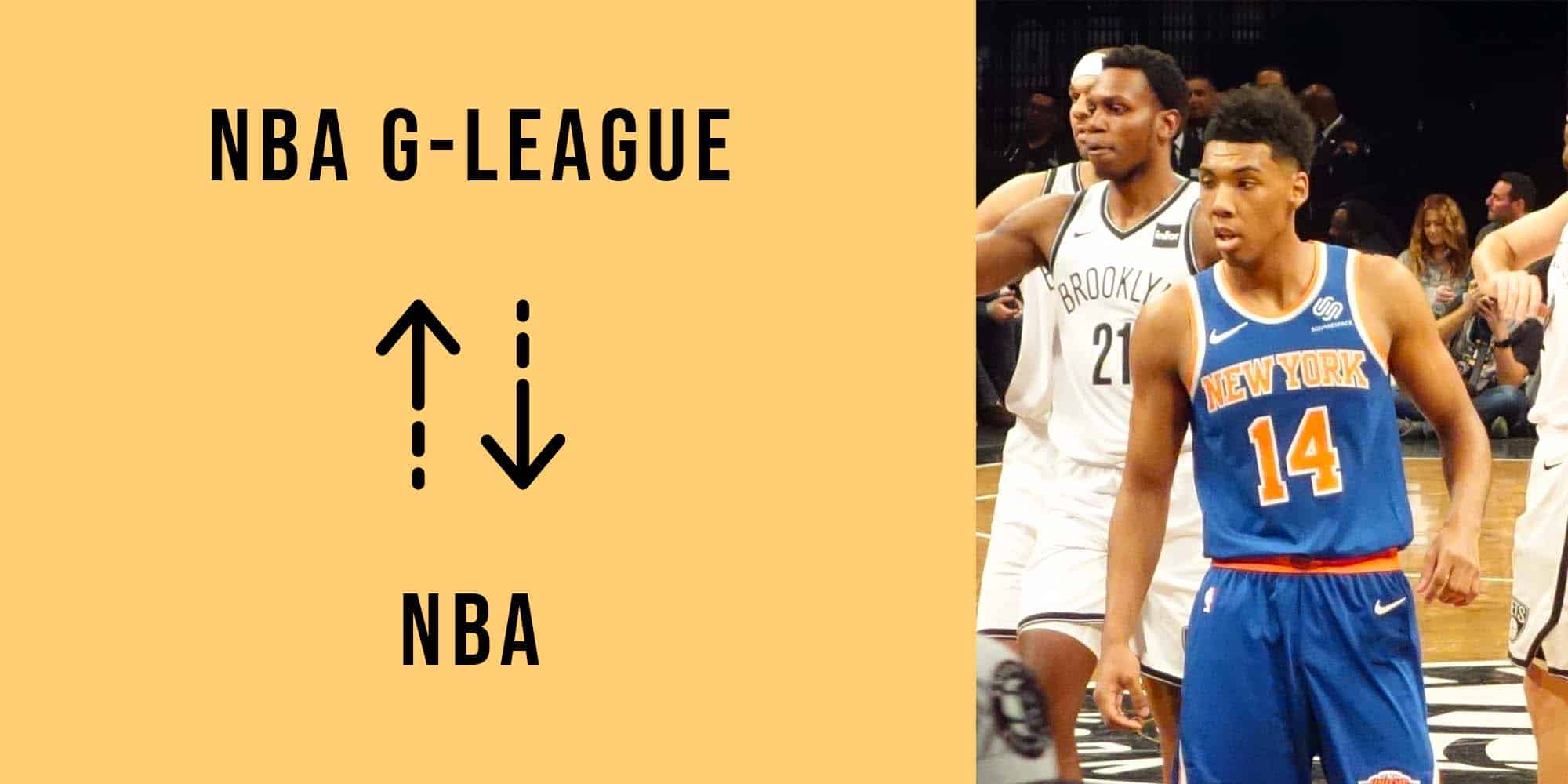You may have heard the term “two-way contract” thrown around in the last couple of seasons. It was a big deal when it was first introduced, but many NBA fans still don’t fully understand how these contracts work. That’s what we’re going to cover today.
What Is A Two-Way Contract?
In the simplest possible terms, a two-way contract allows a player to play in both the NBA G-League and in the NBA at the same time. On these contracts, minor league basketball players spend a portion of their season playing in the NBA and can potentially secure regular contracts if they impress.
When were two-way contracts first introduced?
Two-way contracts first appeared in the NBA prior to the 2017-18 season, through a collective bargaining agreement between the NBA and National Basketball Players Association (NBPA).
They give NBA teams the ability to expand their roster spots from the traditional limit of 15 to 17 players.
That means that an NBA team can only have two two-way players on their roster at a time, and they can not fill the 16th and 17th spot on their roster with traditional contracts.
Why Were They Introduced?
The idea was to give G-League players a better chance to get onto NBA rosters, and also to give NBA teams a better opportunity to evaluate how certain NBA G-League talents fit in with them.
Because two way players don’t count against an NBA team’s roster size limit of 15, they also benefit NBA teams by giving them more options on their roster.
The NBA G-league also benefit a lot from them, as it makes the league a more attractive option to young players considering their future options, and also increases the level of play by putting players with NBA experience in games.
What are the conditions of a two-way contract?
As you’ve probably guessed, there are some conditions that apply here.
In order to be eligible for a two-way contract, a player can’t have more than four years of NBA experience. This restriction makes sense when you consider their primary purpose – helping young talents secure their future in the NBA.
Two-way contracts can be signed for either one or two seasons, but no more than that. Originally, the player who signs it would be limited to spending 45 total days per season with their NBA team, and not permitted to play in the playoffs.
Of course, these are just limits and no time is actually guaranteed with this type of contract, so a team can cut a player whenever they want.
They would spend the rest of the time back in the G-league, unless their NBA franchise signed a standard NBA contract with them.
As we’ll see later, some players managed to turn two-way contracts into legitimate NBA careers, but not everyone has been so lucky.
How much is a two way contract worth?
If you’re a G-League player, getting a shot at the big leagues is probably your dream, and a two-way contract not only gives you a chance to fulfill it, but also to secure a significant payday compared to your G-League salary.
While a two-way player is with their NBA team, they get paid pro rata at an NBA rate (usually the rookie minimum salary), which would initially came out to just over $200k if they spend the full 45 days in the NBA.
For the time spent in the NBA G-League affiliate, they get a salary of around $80k. Note that this is a special salary that is substantially higher than the average salary of G-League players.
Combining the two, you get a total figure that’s just shy of $280k per season.
But because the initial run of two-way contracts was such a success that the limit for players was raised from 45 days to 50 games, leading to a further potential increase in their NBA salary.
2020-21, 2021-22 Season Changes To Restrictions and Salaries
With so many changes impacting the two leagues over the pandemic, two-way contracts were also modified to provide teams with greater roster flexibility.
For the 2020-21 season, two-way contract players would instead receive a fixed salary of $449,155 (half the rookie minimum) in the season, and the 50-games restriction was lifted entirely, meaning two-way players could play the entire regular season and even appear in the NBA playoffs.
For the 2021-22 season, the fixed salary remains at half the rookie minimum (now $462,629) and they can be active for up to 50 of their team’s 82 regular-season games.
It is still unknown whether these changes will be made permanent.
Criticisms of the concept
Some players, such as fan-favorite Alex Caruso, have turned their two-way deals into regular NBA contracts and earned their place in the league, but Caruso’s journey is not the norm.
Multiple agents and even team executives have gone on record saying that they wouldn’t suggest players sign such contracts. The two main reasons are earning potential and lack of bargaining power.
Two-way contracts lure NBA hopefuls into the G-League by giving them an obvious route into the NBA. Play well enough in the G-League, get a two-way contract and then play well enough in the NBA to secure a standard contract. Sounds pretty easy, right?
The problem is that:
- Few players actually get a two-way contract and even fewer players will go on to land a regular NBA contract
- The salary for an ordinary G-league player is low (~$35k per season)
- Many of those players could have secured significant paychecks overseas
In a way, two-way contracts, and the sometimes false hope they offer can cause players to miss out on significant potential earnings because of a dream that may never come true. Basically, you could argue they sell young and aspiring players a dream.
Top levels of European professional basketball not only offer significantly larger salaries than the G-League, but might also be more beneficial for the player’s development and eventual move to the NBA.
Even when a player is on a two-way contract, their negotiating power (or lack thereof) is much different than that of players with regular rookie contracts.
Two-way players are often longshots and, unlike NBA rookies, rarely get a role that lets them showcase their full potential.
If they get into negotiations with their team regarding an extension/guaranteed contract (and that’s a pretty big if) their leverage is next to non-existent.
The NBA and G-League teams love the possibilities a two-way contract gives them, and so do some of the players. The unfortunate truth is that, for some of them, a two-way contract is simply not in their best interest.
It’s Still Early Days…
The two-way contract system is still very much in its infancy and only time will tell if it becomes a consistent source of new NBA talent.
But bridging the gap between minor and major leagues is definitely a good thing, and it definitely appears those in the G-League love the concept. Both the general manager of the Santa Cruz Warriors and the head coach of Rio Grande Valley Vipers have made positive remarks.
Hopefully the NBA will strive to keep iterating the system until it truly works in everyone’s best interests.


I wonder who else has benefited from a 2-way contract other than Alex Caruso?
I do like the new increase in pay of 462K and the ability to play multiple games with the team.
Villanova guard, Collin Gillespie came out undrafted in 2022 and the Nuggests signed him to the 2-way. He could have played overseas and made twice as much but something tells me with his leadershp and ball handeling, he too will be like Caruso and eventually find himself in the Nuggets regular season lineup. 2 way contracts are tricky for sure but in Gillespie’s case, I like his chances.